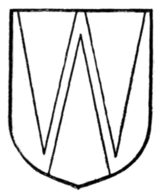in these cases the pall or pallium (Fig. 154), is now considered to have no other heraldic status than that of an appropriately ecclesiastical charge upon an official coat of arms, there can be very little doubt that originally the pall of itself was the heraldic symbol in this country of an archbishop, and borne for that reason by all archbishops, including the Archbishop of York, although his official archiepiscopal coat is now changed to: "Gules, two keys in saltire argent, in chief a royal crown or."
The necessity of displaying this device of rank—the pallium—upon a field of some tincture has led to its corruption into a usual and stereotyped "charge."
THE CROSS
The heraldic cross (Fig. 155), the huge preponderance of which in armory we of course owe to the Crusades, like all other armorial charges, has strangely developed. There are nearly four hundred varieties known to armory, or rather to heraldic text-books, and doubtless authenticated examples could be found of most if not of them all. But some dozen or twenty forms are about as many as will be found regularly or constantly occurring. Some but not all of the varieties of the cross are subject to the lines of partition (Figs. 156-161).






